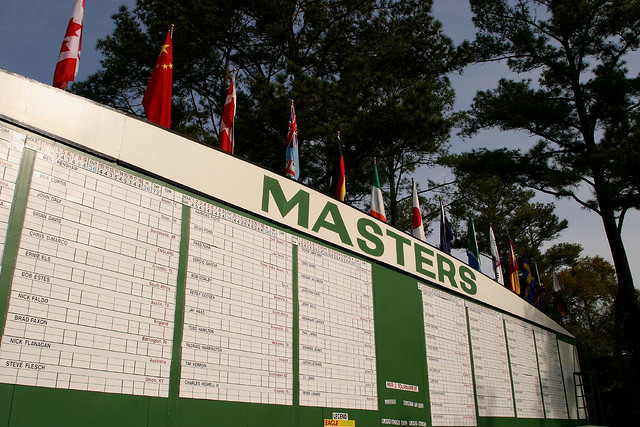The Masters Tournament – or as itֳ more commonly named, The Masters – is arguably the most prestigious and memorable individual golfing tournament on the planet. The Green Jacket, the infamous Amen Corner, the trials and tribulations of so many of golfs greatest exponents played out in the most stunning of amphitheatres; each are symbols and memories that are so easy to recollect, they have rightly become part of international sporting folklore.
From the inaugural tournament in 1934, through Tiger Woods’ unforgettable record-breaking maiden victory in 1997, to Bubba Watson’s miraculous championship clinching hook shot in 2012, Augusta National Golf Club in Georgia has witnessed moments of golfing glory that are unrivalled anywhere in the world.
As Augusta National hosts the 80th Masters Tournament, PhysioRoom.com decided to explore the complete history of the competition from its inception to the present day, covering the highs and lows of one of golf’s truly spectacular and memorable occasions. So get your caddies at the ready, iron the pleats of your garishly chequered trousers and polish your balls to a high gloss shine because, golf fans, it’s tee off time.
If you’re a fan of golf and have thought about playing, but don’t know where to start, check out this guide constructed by our friends over at Golf Influence. Now get out there and hit some balls!
A Tournament Is Born
As you might expect the world was a very different place back in the 1934 (and I don’t just mean everything was in black and white). In America, President Roosevelt was fighting to prevent an auto strike, in Europe a certain Fuhrer was taking his seat at the top table of German politics and in sun-drenched Augusta, Georgia, another big name player was dominating the year’s headlines.
Robert T. Jones Jnr , Bob to his mates, was on the verge of making his comeback in competitive golf. After nearly four years of hiding away, the venue for his return to the limelight was the newly formed Augusta National Golf Club and the setting was the very first Augusta National Invitation Tournament Рwhat we now know and love as The Masters.
At around 10:30am on March 22nd, Bob clattered his tee shot into the distance and strode down what is now the 10th fairway; for him however, much more was at stake than merely his return to the game. This was about the golf club he had envisioned and co-founded, Augusta National, and the tournament that would prove to be his lasting gift to the game he loved. This was about bottling the extraordinary and storing it on a shelf made of golfֳ most unforgettable memories for the rest of time.
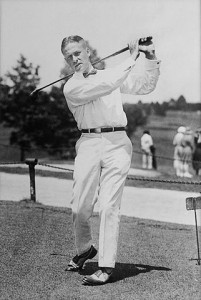
Bob Jones never did anything in an ordinary fashion. As well as successfully completing degrees in English literature and mechanical engineering, he really set the standard for golfing excellence, winning 13 major championships in eight years while still maintaining his status as an amateur (something that seems almost impossible to imagine today).
His crowning achievement came in 1930 when he won all four major golf tournaments of his era (the Open and amateur titles in both the US and UK) and became the only man in history to complete a Grand Slam in a calendar year.
With results like this on his record, Bob became the outright favourite in every event he entered and, hounded by fans and the media (sounds a bit familiar), he began to long for a time when he could just kick back, have a game of golf with his friends and not be surrounded by an expectant entourage.
So, in a move that sent shock-waves throughout the game, Jones retired at the age of 28 and set out to pursue the dream of building his very own golf course. He found a kindred spirit in architect Alister MacKenzie – a man who shared the same values of how the game of golf should be played Рand, in Clifford Roberts, he uncovered the perfect administrator to run and organise the club with a firm and stabilising hand.
Though both Roberts and MacKenzie rightly receive much of the credit for their respective contributions to the creation of Augusta National, and with it the resulting Masters Tournament, there can be no doubt that without Bob Jones Jnr neither the course nor the competition would exist for us to marvel at today.
You could even say that much like the Dogwoods and Azaleas that litter the landscape of Augusta, the spirit of Bob Jones can still be felt throughout the duration of the Masters weekend and beyond. His attention to detail, sportsmanship and sense of fair play are recounted in stories told every year to a new generation of golfing aficionados and his code of etiquette is still compulsory reading for anyone that is lucky enough to visit the course today.
All About Bobby!
Though never being successful at Augusta National, Bobby Jones was the most decorated amateur golfer that has ever competed on a national or international level. Though earning his living mainly as a lawyer, Jones was a hugely popular, impressive and sportsmanlike golfer, capable of beating the very best pros of the 20ֳ and 30ֳ.
A winner of 13 major championships in his short-lived career, he continued to compete at the Masters (on an exhibition basis) until 1948 and continued to make significant earnings from the game thereafter as an instructor and equipment designer Рhelping to design and develop the first set of matched steel-shafted clubs, that are still to this day considered among the best designed sets ever produced.
The Early Years and the Shot Heard Around the World
Though plying his trade upon a course that he had helped to design, Bobby Jones was surprisingly not successful in the inaugural Augusta National Invitational event in 1934. The honour of being the first victor there went to Horton Smith, a 25-year-old professional from Springfield, Missouri who also had the pleasure of being the only golfer to defeat Jones in 1930, the year of his Grand Slam extravaganza.
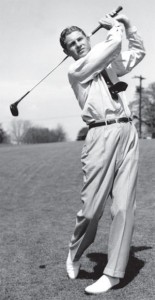
Smith held a share of the lead each day of the tournament and upon winning the debut event he admitted that he, like many, was a fan of the new course, stating that “There is nothing monotonous about that course, it is one of the most beautiful I have ever played.” adding that, “Each one of the holes presents something new.”
Smith went on to win the tournament again in 1936 but the thing that really helped to put the Augusta Invitation on the sporting map, and fired the imaginations of spectators and fans everywhere, came the year before.
In 1935, Gene Sarazenֳ’s ‘Shot heard around the world’ came at the par 5, 15th hole. 235 yards away from the pin and in need of a monumental finish to tie with the leader Craig Wood, Sarazen struck his ball hard and true with a 4 wood and watched as it sailed towards the flag and promptly dropped into the hole for a double-eagle three.
This dramatic feat, coupled with a steady closing three holes, saw Sarazen make it into a 36-hole play-off against Wood which he duly won by five strokes on the Monday in an even par 144 to 149 (+5); making par at the 15th in both playoff rounds.
Wood was finally victorious in 1941 before Byron Nelson Рwinner in 1937 Рwon the final tournament before it was cancelled in 1942 because of America’s involvement in the Second World War. For the duration, to assist in the war effort, Augusta National was used to rear cattle and turkeys and, for the while, golf was consigned to mere memories.
Trivia Birdie!
The first tournament holds the distinction of being the only one played with the current holes 10 through 18 as the first nine and then 1-9 as the second nine. This was permanently reversed in the 1935 tournament.
Traditional Awards and a Famous Green Jacket
As you might expect The Masters has many traditions and customs, some more well-known than others, but by far and away the most famous and recognisable of these rituals is the Green Jacket presentation.
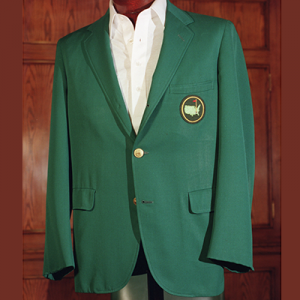
Since the first of Sam ‘Slammin Sammy’ Snead, three Masters victories in 1949 the winner of each Masters tournament has been presented with a distinctive ‘Augusta Green’ jacket. The sports coat is the official get-up worn by club members while they are on club grounds and, as each winner of the tournament becomes an honorary member of the club, it seems only right that the tradition be upheld.
First-time winners are allowed to keep hold of their jacket for the first year after they have won the tournament, at which time they must return it to Augusta National where it will reside alongside those of other champions and be available for each to wear every time they come back to play or visit.
Traditionally it is the previous yearֳ champion that will present this sartorial emblem of golfing greatness to the victor; first in the clubhouse as a matter of tradition (and for the gods of TV to make it look all cosmopolitan and cool and chic and such) and then they will again present it out on the 18th green in order for the fans and golfing enthusiasts to take photos and create their own lasting memories of the occasion.
In 1966, when the inimitable Jack Nicklaus became the first person to win back-to-back tournaments, he was given the somewhat onerous task of presenting the jacket to himself. Realising the error of their ways, when future repeat champions (Faldo in 1990 and Woods in 2002) received the jacket, the chairman of Augusta National was given the honour.
As well as the now timeless green jacket, there are several distinctive awards that are given out to players that achieve feats of exceptional golfing ability throughout the championship weekend.

The player with the lowest on each day will receive a crystal vase, while any player that makes a hole-in-one or a double-eagle will get their hands on a crystal bowl. A pair of crystal goblets are given out for each eagle a player makes and the winner of the par 3 competition, that is played the day before the tournament begins, will also receive a crystal bowl (that is one hell of a lot of quartz!).
The winners are not just left with the jacket to show for their trials and tribulations around the 72+ holes they have completed either. As well as the honour of being named champion, they have their name engraved on the beautiful solid silver Masters trophy that was introduced to the tournament in 1961 and also get to take home a gold medal.
Though the trophy itself remains at Augusta, since 1993, the winner has also received a sterling silver replica that is theirs to keep and in honour of the amateur golfer that helped to establish the tournament in the first place, the leading amateur player has received an award known as the Silver Cup since 1952.
The Par 3 Contest
Traditionally played on the Wednesday before the tournament, the par 3 contest was first introduced in 1960. The nine-hole course – measuring just 970 metres in length – was created in 1958 and has seen a staggering 73 hole-in-ones throughout its history, with a record five occurring in 2002.
Amazingly no winner of the par 3 tournament has gone on to win the Masters outright in the same year. The event sees many golfers using their children as caddies which helps to engender the family-friendly atmosphere of the Masters.
The 1950’s
Following the horrors of WWII the game of golf was dominated by Slammin Sammy and Ben Hogan; one of which won the green jacket every year barring one between 1949-54.
Hogan, who had twice been runner-up before, broke through to secure his first green jacket in 1951 and followed it with a suggestion that led to the beginning of a tradition that is still observed to this very day; a dinner for champions held each Tuesday of tournament week, now known as The Champions Dinner.
The back-and-forth of Snead and Hoganֳ championship victories set the stage for 1954 and for one of their most memorable battles. Tied after 72 holes at 1-over-par, they both entered the 18-hole playoff on Monday with aspirations of becoming only the second man to win three Masters titles (the first being Jimmy Demaret in 1950).
Electing to lay-up on the short par-5 13th Hogan handed the initiative to Snead who had gone for the green in two and made it, setting up an easy birdie opportunity that gave him a one-stroke lead that Hogan never got back. It would be the third and final victory at the Masters for Snead and for Hogan, the second time he had lost in a playoff at Augusta, making him still, to this very day, the only man to lose twice in a play-off at The Masters.
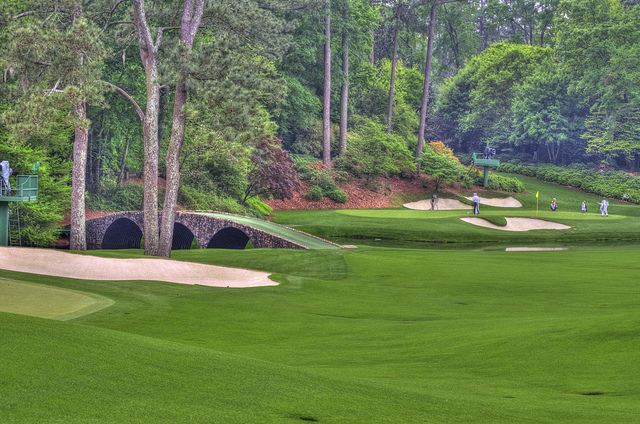
Down in the Amen Corner
Given the name by veteran golf journalist and jazz enthusiast Herbert Warren Wind, the famous stretch of holes, numbers 11, 12 and 13 was allegedly named after a song recorded by Milton Mezzrow called ‘Shoutin’ in That Amen Corner'(though we can find absolutely no evidence of this).
The year was 1958, a young pro named Arnold Palmer won the tournament for the first time and Wind decided to combine his two favourite passions and come up with a name to describe the action unfolding in front of him, a name that is now synonymous with The Masters.
Describing Palmers troubles with a rule controversy at the 12th hole that saw him have to play two balls, Wind wrote for Sports Illustrated: ӡ wonderfully evocative ceremony took place at the farthest reach of the Augusta National Course Рdown in the Amen Corner where Raeֳ Creek intersects the 13th fairway near the tee, then parallels the front edge of the green on the short 12th and finally swirls alongside the 11th green.
Thankfully, and almost impossibly poetically, the name has stuck ever since.
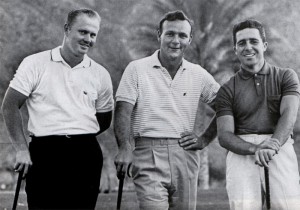
1960/70’s РA Golden Generation of Golf
From 1960 all the way up to 1978, the Masters was dominated by the Big Three – Arnold Palmer, Gary Player and Jack Nicklaus. Between them they won the event twelve times during that period, with numerous records broken and many first-in-history stories written.
Widely credited with bringing the game of golf into the homes of millions and making it the popular sports behemoth that it is today, the Big Three will always be remembered as the men that revolutionised the sport.
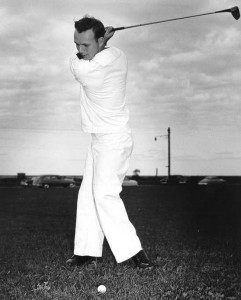
Arnold Palmer
Already a champion back in 1958, Palmer would go on to win four Masters in total, including the 1960, ’62 and ’64 tournaments. Nicknamed ‘The King’ he is regarded as one of the greatest golfers of all time and one of the game’s most important trailblazers, because he was one of the first superstars of the television age.
Palmer had a much more intriguing and important social impact than perhaps any of his peers or predecessors did because of his humble background and plain-spoken popularity. His approach to the game, coupled with his working-class sensibilities, made golf less of an elite, upper-class pastime than it had previously been and, alongside Nicklaus and Player, he can be thanked or blamed (depending on your viewpoint) for popularising and thus commercialising the game.
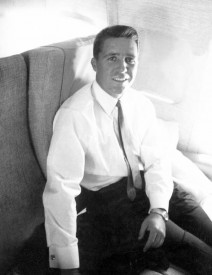
Gary Player
South African, Gary Player became the first overseas winner of the Masters in 1961 and when he was victorious in the US Open in 1965, he became the only non-American to complete the career Grand Slam of winning all four major championship tournaments, and at the time, was only the third man in history to complete the feat, following Hogan and Sarazen.
Though Player was victorious in ն1, it took him another 13 years to win again at Augusta. He was runner-up a number of times however, both to Palmer and Nicklaus, and the man they call ‘The Black Knight’ ‘Mr Fitness’ and the ‘International Ambassador of Golf’ was always there or thereabouts throughout the golden age of golf.
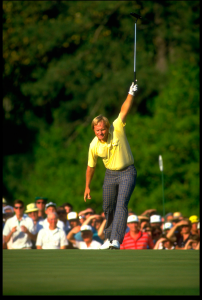
Widely regarded as the greatest of all-time, Nicklaus has won the Masters more than any other golfer in history and was the first man to defend the title when he followed up his course record breaking victory in 1965 (271) Рa performance that Bobby Jones called “The greatest performance in all of golfing history” – with another green jacket clinching performance in 1966.
Nicklaus, lovingly known as The Golden Bear – completed the career grand slam in 1966, when he won the Open Championship at Muirfield, making him, at the ripe young age of 26, the youngest man to do so at the time. A winner of a record 6 Masters tournaments Nicklaus chalked up three of those titles throughout the 60’s and another two in the 70’s before his career took a downward turn. He would however make a stunning return to the top of the standings in 1986, when he became Рand still remains Рthe oldest man to win the tournament, at the age of 46. He also holds the record for the greatest number of Major tournament victories with 17 in total.
Racism, Sexism and Slowly Changing Perceptions
From the beginning of its creation, Augusta National had a set of bylaws that would be seen by most people today as shocking, draconian and downright sexist and racist. Up until it became defunct in 1959, the club had a policy that stated that all caddies (the people that carry the clubs for those of you that donִ know) had to be African-Americans.
In 1975, Lee Elder became the first black man to play in the Masters. Shockingly, this took place a whole 15 years before Augusta National had even admitted its first black member and women were not even allowed to join until much later in 2012.
Even to this day the club has defended its membership selection policies, stressing that as a private organisation, it is allowed to be as selective with who it allows on the greens and in the clubhouse as it likes.
1980’s / 2000’s The Rise of the Non-Americans
There were 11 victories for non-Americans in 20 years in the 80ֳ and 90ֳ, results that were by far and away the most prolific in any of the American majors since the early days of the US Open Championship.
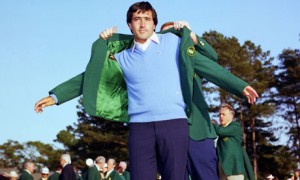
The first European to stake his claim and win the Masters title was none other than Seve Ballesteros in 1980. The then 23-year-old Spaniard had set his sights on Nicklaus’ course record of 271 (-17) and was close to it after making the turn on the final day at 16-under-par. But as he made his way round the infamous Amen Corner he found the water at both 12 and 13, had his lead reduced to three and fought valiantly to recover with birdie at 15 and pars at the remaining three holes. He had finished his final round in an even-par 72 and had taken the title with a four round total of 275, four shots behind the record.
The pressure of performing at Augusta is capable of breaking the very best golfers in the world. Never has this been truer than for Australian golfer Greg Norman. The Great White Shark, as he was known, came close to winning the Master numerous times throughout the 80’s and 90’s, losing in a play-off to Larry Mize in 1987 and, after equalling the course record with a first round 63 in 1996, he proceeded to throw away a six-stroke lead and hand Nick Faldo his third title.
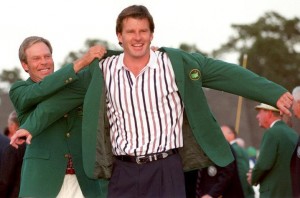
Norman also had trouble when Nicklaus won his last Masters in 1986. After birdieing four straight holes Рand needing only a par to tie Nicklaus for the lead Рhe inexplicably pushed his approach to 18 wide of the mark and after missing his par putt, finished one stroke behind with a bogey.
The European contingent was strong all throughout the 80’s and 90’s. After Seve had blazed his trail in 1980, he won again in ո3 and was runner-up to German maestro Bernhard Langer in 1985.
The late 80’s and early 90’s saw Europeans dominate at Augusta like never before. First Scotland’s Sandy Lyle in 1988, then Faldo in ’89 and ’90 and finally the diminutive Welshman Ian Woosnam in 1991 all kept the stars and stripes out of the green jacket for five long years.
This cat and mouse back-and-forth between America and Europe coincided with the ever growing popularity of the Ryder Cup and then, in 1997, the world of golf witnessed something that would change its landscape for ever more.
“Come On Tiger!”
Jack Nicklaus’ 32-year course and youngest-winner-ever records were finally broken in 1997. The man that did it was a 21-year-old Californian named Eldrick Tont Woods, Tiger to you and me.
Having only turned professional in the summer of 1996, Tiger’s win at the Masters was something of a revelation. After an outstanding amateur career and within three months of his maiden major victory, he was the number one golfer in the world.
Tiger has gone on to break countless golfing records. He has been the world number one for the most consecutive weeks, spending 264 of them in the top spot between August ’99 – September 2004 and another 281 weeks between the summer of 2005 and October 2010. He has been named as the PGA player of the year a record 11 times, won nearly 80 PGA tour events and trails only Nicklaus in Major victories on 14.
As well as these records, Woods also holds the record as the youngest player to achieve the career Grand Slam, as well as the youngest and fastest to win 50 tour events, and he is only the second golfer to have completed the career Grand Slam three times. Though injuries have plagued his most recent years in competition, he remains one of the most revered and fearsome competitors out on the course.

Trivia Birdie!
Tiger Woodsՠfather Earl once said that Tiger first beat him at the age of eleven and, following that maiden victory, he never managed to get the better of his son over 18 holes ever again.
The Rise and Rise of the Lefties

Amazingly it took until 2003 for the first left-handed golfer to take the title at Augusta. The honour went to Canadian Mike Weir. Weir was also the first Canadian to win the championship in its near seventy-year history.
Almost ironically and much like the proverbial two buses coming at once, the following year another leftie was sliding himself into the green jacket after a gruelling 72 holes of golf.
Phil Mickelson had long been the nearly-man in the major golf tournaments; forever the bridesmaid and never the bride. But in 2004 he managed to sneak over the line when a birdie at the final hole gave him a one-shot lead over South African stalwart, Ernie Els. This victory seemed to open the floodgates for Mickelson who went on to clinch the title again in 2006 and 2010.

The left-handers were not done there though. In 2012 the wonderfully-named Bubba Watson became the fifth left-hander to win the Masters in the previous ten tournaments; clinching victory with one of the most stunning shots ever seen at Augusta.
Playing the second play-off hole against Louis Oosthuizen of South Africa, Watson found the pine needles way off the right of the tenth fairway in what many commentators called ‘being in jail’, but in a show of tremendous skill and unparalleled bravery, he hooked the ball an incredible 45-yards to the right and managed to land it on the centre of the green to leave him two putts for par and his first Masters; a shot that many have said is one of the greatest ever seen at Augusta.
The Record Books
As you might expect, with a game that is all about the numbers, there are many varied and impressive golfing records that have been set at The Masters.
Many of those records are held by Nicklaus and Woods. The Great Bear holds the distinction of having won the tournament more than any other golfer with six victories, and he is also the oldest champion too; his 1986 victory coming when he was 46 years, 82 days old. Nicklaus also holds the record for the most top-ten finishes at Augusta, with 22, and the most cuts made, with 37.
Woods is the youngest ever winner of the Masters, collecting his green jacket from Nick Faldo in 1997 at the age of 21 years, 104 days and he also broke the record that year for the widest winning margin (12 strokes) and the lowest winning total, with 270 (-18).
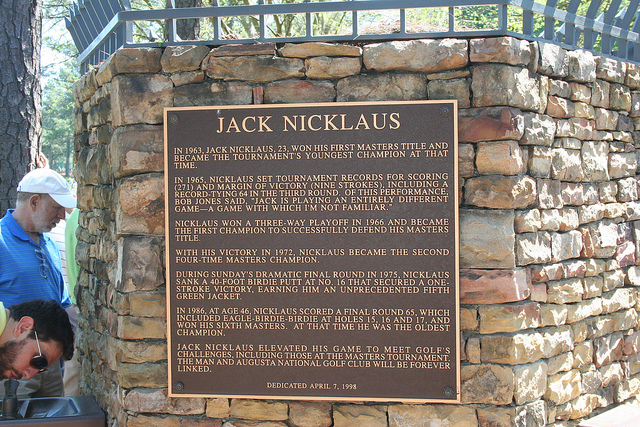
The youngest man to ever compete in a Masters tournament, and subsequently the youngest to ever make the cut there too, was Guan Tianlang, who was 14 years, 168 days old at the start of the 2013 tournament Рhow many teenagers do you know can make that claim?
The record for the most appearances at Augusta, with a simply astounding 52, is held by The Black Knight himself, Gary Player. Player also has the record for the number of consecutive cuts made; though he didnִ’t compete in 1973 due to illness, he leads the pack with 23 between 1959 and 1982. He does, however, have to share this record with Fred Couples who also made 23 consecutive cuts between 1983 and 2007, though on this one we give the record outright to Player, because Couples missed both the 1987 and 1994 tournaments.
Nick Price and Greg Norman are both tied on 63 for the record of the lowest score for a single round at Augusta. This is also the lowest round scored in Major Championship golf, which has been achieved 25 times by 23 different players Рthe first by Johnny Miller in 1973 and his sensational final round in the US Open at Oakmont in which he hit all 18 greens in regulation.
He Who Plays, Is Invited
The Masters has always been an invitation tournament. The field of competitors is much smaller than at any other Major golf tournament there is and to qualify for an invitation you have to be one of the top 50 golfers in the world. This is determined by the Official World Golf Ranking system.
Past and former champions are all invited to play alongside their modern contemporaries – however, since 2002, Augusta National Golf Club has discouraged them from playing at an advanced age. In total there are 18 different qualifying criteria and in addition to these, The Masters Committee reserve the right to invite any other golfer not otherwise qualified – for example, in 2015 the winner of the newly-established Latin America Amateur Championship earned an invite to Augusta.
In The End
The 80-year history of this famous tournament has provided many of golf’s most memorable moments. Players have always prepared impeccably for the tournament and it is the only competition that is shown simultaneously on both Sky Sports and the BBC in Britain – a sure sign of its importance and significance to lovers of the sport on these shores.
Its spiralling dogwoods and blossoming azaleas, its tall pines and weaving, rippling brooks, all help Augusta National provide a setting that is arguably unrivaled in the world of golf. The green jacket, a symbol of greatness that is revered the world over, and the title – The Masters Рare sure to forever be synonymous with greatness in a sport that is amongst the most high-profile and sportsmanlike in the world.
Bobby Jones Junior would surely have been proud.
Enjoy the tournament and long live The Masters.


